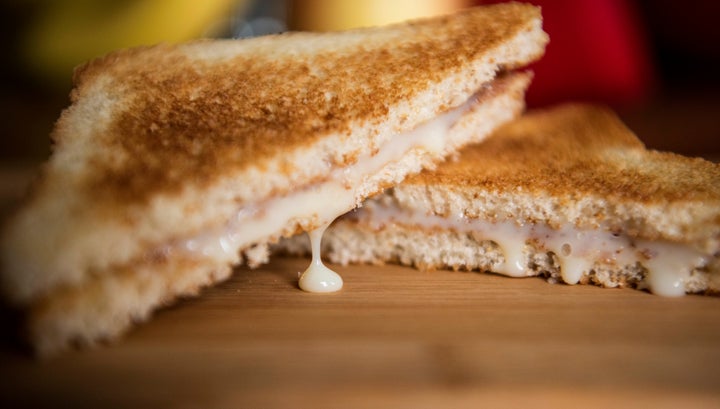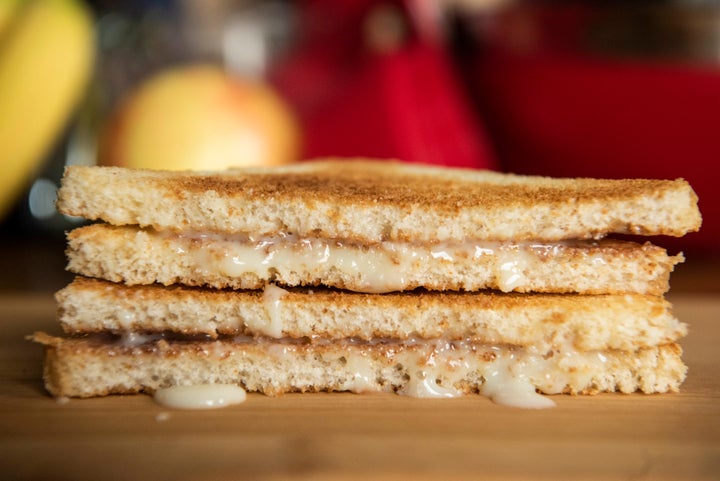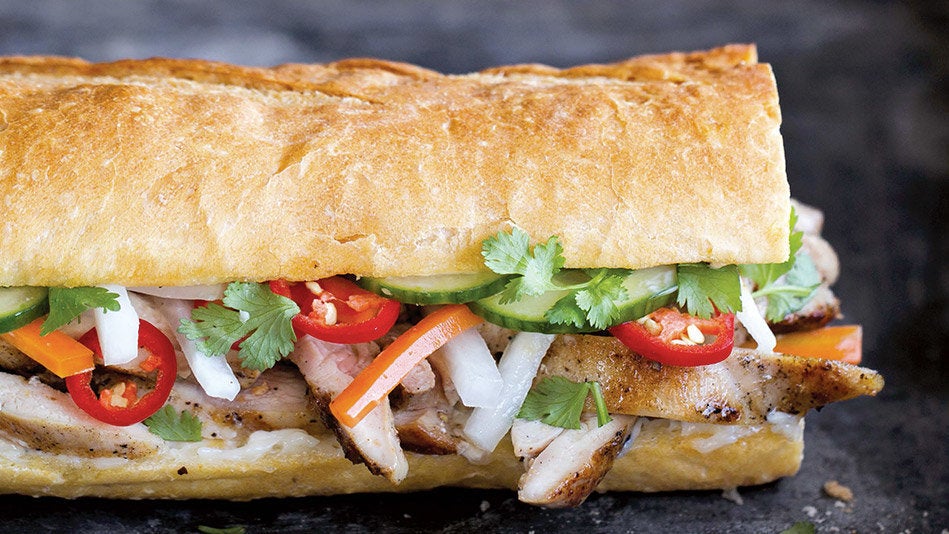
For me, a person born in Texas and raised partly in Hong Kong, something like a peanut butter and jelly sandwich has never really been my thing. It feels foreign ― heavy and dry in my mouth.
When I think of a childhood sandwich that creates the same enthusiasm that PB&J does for many Americans, it has to be a Hong Kong-style sweetened condensed milk sandwich. While sweetened condensed milk (often shortened to just “condensed milk” in other countries, such as the U.K.) is mostly used in the States for candy-making, it becomes a sandwich filling and toast topping in other parts of the world.
Sweetened condensed milk is either spread atop one slice or sandwiched between two pieces of buttered and toasted white bread for a warm and sticky treat, served most often as a part of breakfast or as a light snack at tea time. It’s a common item on any Hong Kong cafe menu.
For a real showstopper, a peanut butter (or cream cheese!) sandwich is dredged in egg, fried like French toast, then drizzled with sweetened condensed milk in lieu of syrup. But my favorite has always been the simplest: cottony soft, white bread toasted for a buttery, crisp exterior with sweetened milk in the center.
For me, this sandwich contains multitudes. From the lowbrow sweetened condensed milk to the most processed of white breads, this sandwich is a metaphor for how the reaching arms of colonialism stretch out to touch everything, its almighty presence creating new trade routes, new cultures, new people. Condensed milk toast, as it is often called, becomes a representation of who I am, where I come from and the circuitous route that food often takes to help shape a national identity.
Today, soft, pillowy bread goes against the grain: Wholemeal, heritage flours and naturally leavened sourdoughs have come into vogue. But bread, particularly the industrially processed kind, has always had a unique place in the history of Hong Kong. The British influence on Hong Kong food culture has been well-documented, and bread was an integral part of that. Bread even inspired an attempted mass murder.
The whitest, most processed fluffy bread is often the most sought after in Asian baked goods and what is used for a sweetened condensed milk sandwich. It is a delight, a comfort to those who know it. For somebody who has a foot in both worlds, Western and non-Western, this bread is often a guilty pleasure that conjures up nostalgia.
But what’s inside the bread is what really counts.
Growing up in my household, we always had cans of sweetened condensed milk for various things ― coffee, tea and obviously, toast. I’d watch my father carefully open the can, tip the tin of milk on an angle and watch as it heaved itself out of the can and into a blue plastic Rubbermaid we saved solely for this purpose. I would wait, hoping he’d let me scrape the can with a spoon at the end. Little did I know, though, how important sweetened condensed milk was to both Texas history and Hong Kong, and even within the cultures of other former colonized countries such as Brazil and Mexico. The grip that canned goods, sugar and flour has had on these places is unsurprising when one thinks about the perishability of fresh foods.

In Hong Kong, sweetened condensed milk sandwiches and toast can be found in a cha chaan teng, a casual cafe of sorts. A cha chaan teng typically serves what one tourist calls “a diner-ification of fancy Western fare,” a mix of European food made with Chinese ingredients, like macaroni soups, salt-and-pepper wings or scrambled tomato eggs.
The cha chaan teng was born in post-WWII Hong Kong, where my father was raised when his family, like so many others at the time, fled China and the Communist stronghold. In this historical moment, industrialization grew and the influx of immigrants and factories produced instant noodles and other processed foods for importing and exporting. An interest in Western food combined with new ingredients like macaroni or instant noodles created its own type of cuisine, specific to the time and place. Factory workers needed cheap, quick sustenance and would find it in a cha chaan teng. It was in places like these my father encountered sweetened condensed milk on toast, most likely savoring the sticky sandwich as much as I did growing up.
But as a child, I never had condensed milk sandwiches at a cha chaan teng in Hong Kong, but rather in Houston at Hong Kong-style cafes owned by friends of my father. And the places we went to in Texas were no different, serving foods that at first glance didn’t appear to belong together to people who probably didn’t feel like they did either. But it is also an uncanny coincidence (pun intended) to eat a sweetened condensed milk sandwich in Houston, a landmark in the history of canned milk. Sweetened condensed milk is similar to how food writer Laurie Woolever describes a cha chaan teng: “a tableau equal parts Chinese and British, a little bit American, glancingly Australian, and creepingly global.”
It was, after all, Gail Borden Jr. of Texas who invented and patented the process to condense milk by heating it slowly in a vacuum pan until the water had evaporated. When this milk was preserved with sugar and canned, it could travel far and wide. In an email exchange, Houston-based food writer David Leftwich told me the story of how Borden’s invention in Texas became a global phenomenon, changing food preservation all over the world. Borden had been an inventor for some years, but with the dawn of the American Civil War, the need for canned goods and supplies increased as soldiers went to war. Borden was able to sell his newest invention, sweetened condensed milk, to the Union Army for soldiers who appreciated its “unique taste and longevity, since it could last for years if left unopened,” according to the American Battlefield Trust.
The British, as an empire that was quickly expanding, needed supplies that wouldn’t perish as they made their way to places far away from England. While fresh milk could spoil due to long supply chains, canned milk was portable, long-lasting and, most importantly, safe. For the British expats who had made their way to places such as Hong Kong, tea time was still a national pastime, and sweetened condensed milk allowed them to keep many of their traditions and, perhaps unwittingly, pass them on to generations of Chinese.
As a child, my father would pick me up from school and we’d stop off at a friend’s cha chaan teng for our very own “tea time.” He’d chat with friends while drinking milky tea and I would snack on sweetened condensed milk sandwiches, crusts off in the style of a British tea sandwich, a dainty little reminder of our history. When I was growing up, I’d mention my love of sweetened condensed milk and the sandwiches made from it to people, including my mother. They would wrinkle their noses or frown and ask, “Like, from the can?” so I stopped suggesting it. In time, it became something I assumed to be almost like a secret, something shared between my father and myself, a family sandwich, of sorts.
A generation and several countries removed, I don’t understand the hardships my father and his family may have withstood on their journey from Shanghai to Hong Kong, or what it means to have been a colonial subject and then, suddenly not. But to be seen as foreign, frowned upon and not quite belonging here nor there ― this I get.
To love canned milk and white bread, to see them as special, is its own mode of survival and invention. Taking the lowliest of ingredients, items people deem mundane or pedestrian, and transforming them to spread sweet, preserved milk on toast with what writer Elaine Castillo calls “shame-free exuberance and practicality” is, in and of itself, its own reappropriation.
